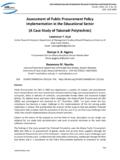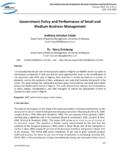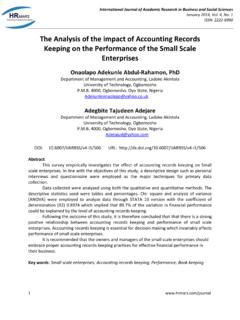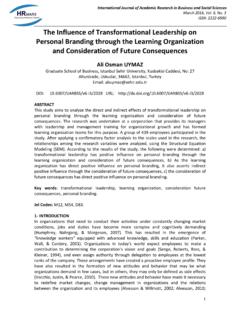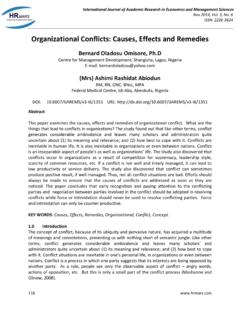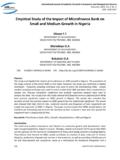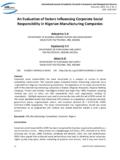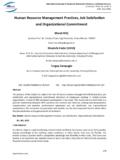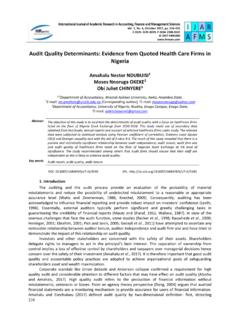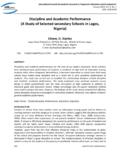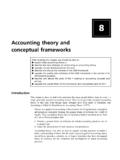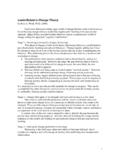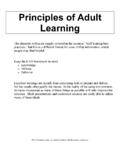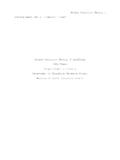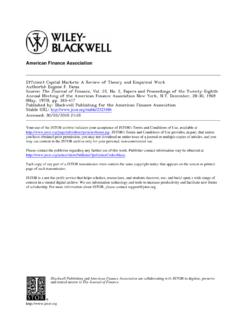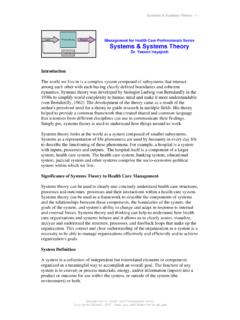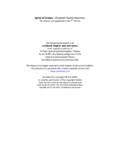Transcription of Fraud Triangle Theory and Fraud Diamond Theory ...
1 International Journal of Academic Research in Accounting, Finance and Management Sciences Vol. 5, , October 2015, pp. 38 45 E-ISSN: 2225-8329, P-ISSN: 2308-0337 2015 HRMARS Fraud Triangle Theory and Fraud Diamond Theory . Understanding the Convergent and Divergent For Future Research Rabi u ABDULLAHI1 Noorhayati MANSOR2 1,2 Universiti Sultan Zainal Abidin 1E-mail : 2E-mail: Abstract Many of the world s most prominent organizations have experienced large-scale frauds. These frauds have had disturbing effects on our world s economy in addition to contributing unnecessary suffering and increased unemployment for the low and middle class.
2 With the aim of further understanding the fundamental motivations of Fraud , this paper takes an in-depth look at the convergent and divergent of two classical Fraud theories which are: (i) Fraud Triangle Theory ; and (ii) Fraud Diamond Theory . This comparison is important to assist anti-graft bodies and organizations in formulating a practical strategy to prevent and investigate organizational frauds. The paper takes a conceptual approach by first examining the concept of Fraud , then discussing the convergence of the two classical theories, and finally differentiating them.
3 By doing so, the similarities and differences between them are highlighted and appreciated for Fraud prevention purposes. The study uses secondary sources of information obtained from journal articles, textbooks and the internet. The discussion of the two theories contributes to the understanding of frauds especially by forensic accountants, auditors, Fraud examiners and other anti- Fraud bodies. The study also serves as guidance for further Fraud related research.
4 Key words Fraud , Fraud Diamond Theory , Fraud Triangle Theory , forensic accounting DOI: URL: 1. Introduction In recent years, corporate financial accounting scandals no longer become unexpected news of the day. Cases such as Enron, WorldCom, Global Crossing and Tyco are among the most prominent ones who had suffered from the devastating impact of Fraud . These costly scandals have increased global concerns about Fraud , wiping out billions of dollars of shareholder value, and led to the erosion of investors and public confidence in the financial markets (see, Peterson and Buckhoff, 2004; Rezaee, Crumbley and Elmore, 2004 in Bierstaker, Brody and Pacini 2006).
5 Many studies have discussed Fraud -related issues, and the general view is that Fraud prevention should be the main focus. It is less expensive and more effective to prevent Fraud from happening than to detect it after the occurrence. Usually, by the time the Fraud is discovered, the money is unrecoverable or the chance to recover the full amount of the loss is very slim. Furthermore, it is costly and time consuming to investigate frauds especially involving large-scale multinational operations.
6 However, if the focus is on Fraud prevention all the monetary losses, time and effort to reconstruct fraudulent transactions, track down the perpetrator, and reclaim missing funds can be saved. Thanasak (2013:1) states that before making any efforts to reduce Fraud and manage the risks proactively, it is important for the business organizations to identify the factors leading to fraudulent behaviour by understanding who are the fraudsters, when and why frauds are committed.
7 Various theories have attempted to explain the causes of Fraud and the two most cited theories are the Fraud Triangle Theory (FTT) of Cressey (1950) and Fraud Diamond Theory (FDT) of Wolfe and Hermanson (2004). Both of them identify the elements that lead perpetrators to commit Fraud . According to Dorminey, Fleming, Kranacher, and Riley (2010), the origin of the FTT dates to the works of Edwin Sutherland (1939) who coined the term white-collar crime, and Cressey was one of Sutherland's former students.
8 Cressey (1950) focused his research on the factors that lead individuals to engage in fraudulent and unethical activity. His research later became known as the FTT. This Theory consists of three elements that are necessary for Fraud to occur: (i) perceived pressure, (ii) opportunity, and (iii) rationalization. David T. Wolfe and Dana R. International Journal of Academic Research in Accounting, Finance and Management Sciences Vol. 5 (4), pp. 38 45, 2015 HRMARS 39 Hermanson believed that the former FTT has to be enhancing to improve both Fraud prevention and detection by considering an additional element above the three, mentioned elements of FTT.
9 They considered four sided FDT thereby adding capability as the fourth element. Wolfe and Hermanson (2004, p. 38) state that Fraud cannot successfully conceal unless the fraudster has the capability to have all personal traits and abilities even in the presence of the other three elements. In their separate works, Wolfe and Hermanson (2004), Thanasak (2013), Norman and Faizal (2010), Florenz (2012), Gbegi and Adebisi (2013) examined and discussed the FDT. Their main conclusion was that the FDT is an extended or improved version of the FTT with an addition of capability added to the three basic elements of Fraud in the FTT.
10 Therefore, this paper aims to explain further the convergent and divergent between the FTT and FDT. 2. Fundamental Concept of Fraud Fraud has grown rapidly over the last few years, and there is a growing trend for large organizations to consider hiring professionals such as forensic accountants to reduce the pressure and potential of occupational, financial frauds. ACFE (2010) and Sutherland (1943) occupational Fraud is the process of using one's occupation or responsibility to satisfy his personal interest by enriching himself through the deliberate abuse of power.
